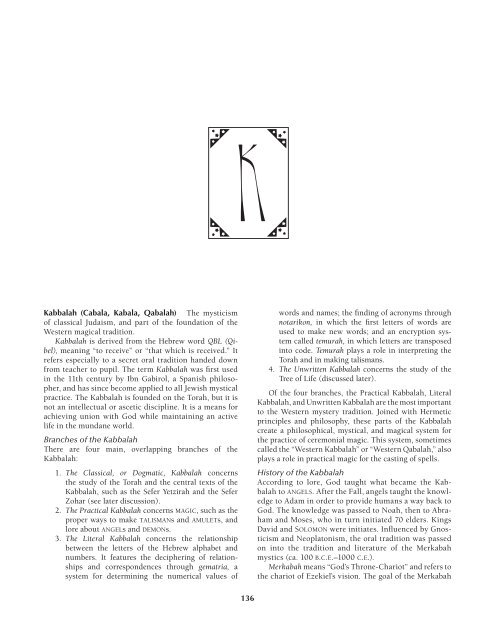The Encyclopedia Of Demons And Demonology
The Encyclopedia Of Demons And Demonology
The Encyclopedia Of Demons And Demonology
You also want an ePaper? Increase the reach of your titles
YUMPU automatically turns print PDFs into web optimized ePapers that Google loves.
K<br />
Kabbalah (Cabala, Kabala, Qabalah) <strong>The</strong> mysticism<br />
of classical Judaism, and part of the foundation of the<br />
Western magical tradition.<br />
Kabbalah is derived from the Hebrew word QBL (Qibel),<br />
meaning “to receive” or “that which is received.” It<br />
refers especially to a secret oral tradition handed down<br />
from teacher to pupil. <strong>The</strong> term Kabbalah was first used<br />
in the 11th century by Ibn Gabirol, a Spanish philosopher,<br />
and has since become applied to all Jewish mystical<br />
practice. <strong>The</strong> Kabbalah is founded on the Torah, but it is<br />
not an intellectual or ascetic discipline. It is a means for<br />
achieving union with God while maintaining an active<br />
life in the mundane world.<br />
Branches of the Kabbalah<br />
<strong>The</strong>re are four main, overlapping branches of the<br />
Kabbalah:<br />
1. <strong>The</strong> Classical, or Dogmatic, Kabbalah concerns<br />
the study of the Torah and the central texts of the<br />
Kabbalah, such as the Sefer Yetzirah and the Sefer<br />
Zohar (see later discussion).<br />
2. <strong>The</strong> Practical Kabbalah concerns MAGIC, such as the<br />
proper ways to make TALISMANs and AMULETs, and<br />
lore about ANGELs and DEMONs.<br />
3. <strong>The</strong> Literal Kabbalah concerns the relationship<br />
between the letters of the Hebrew alphabet and<br />
numbers. It features the deciphering of relationships<br />
and correspondences through gematria, a<br />
system for determining the numerical values of<br />
words and names; the finding of acronyms through<br />
notarikon, in which the first letters of words are<br />
used to make new words; and an encryption system<br />
called temurah, in which letters are transposed<br />
into code. Temurah plays a role in interpreting the<br />
Torah and in making talismans.<br />
4. <strong>The</strong> Unwritten Kabbalah concerns the study of the<br />
Tree of Life (discussed later).<br />
<strong>Of</strong> the four branches, the Practical Kabbalah, Literal<br />
Kabbalah, and Unwritten Kabbalah are the most important<br />
to the Western mystery tradition. Joined with Hermetic<br />
principles and philosophy, these parts of the Kabbalah<br />
create a philosophical, mystical, and magical system for<br />
the practice of ceremonial magic. This system, sometimes<br />
called the “Western Kabbalah” or “Western Qabalah,” also<br />
plays a role in practical magic for the casting of spells.<br />
History of the Kabbalah<br />
According to lore, God taught what became the Kabbalah<br />
to ANGELS. After the Fall, angels taught the knowledge<br />
to Adam in order to provide humans a way back to<br />
God. <strong>The</strong> knowledge was passed to Noah, then to Abraham<br />
and Moses, who in turn initiated 70 elders. Kings<br />
David and SOLOMON were initiates. Influenced by Gnosticism<br />
and Neoplatonism, the oral tradition was passed<br />
on into the tradition and literature of the Merkabah<br />
mystics (ca. 100 B.C.E.–1000 C.E.).<br />
Merkabah means “God’s Throne-Chariot” and refers to<br />
the chariot of Ezekiel’s vision. <strong>The</strong> goal of the Merkabah<br />
136












